

Lumix S5II review – a Panasonic camera with good autofocus, finally!
Thanks to the new phase-detection autofocus, the Panasonic Lumix S5II is a genuine contender to Sony, Canon and Nikon models. Its focus isn’t quite as polished as that of the competition, but the camera’s got other strengths.
Panasonic cameras have occupied a market niche so far. They always scored «good» in test reports, but it was never enough to hold a candle to the holy trinity of full-frame camera manufacturers: Sony, Canon and Nikon. These have virtually no weaknesses. On the other hand, Panasonic’s autofocus was an Achilles’ heel. The Lumix S5II has changed this – and the camera’s finally worth recommending. Especially when it comes to video, it offers good performance at a fair price and more pro features than the competition.
Design and specs: a proper improvement
The S5II looks practically the same as its predecessor; the shape of the magnesium casing remains unchanged. I find them a bit too angular and prefer how the current Sony and Canon models in particular feel in my hand. In terms of size and weight, the Panasonic is in line with other compact full-frame cameras. The build quality is solid, and Panasonic states the camera is splash-proof and resistant to dust. In my case, it survived a fall into the fresh snow, which then melted on the camera. The new ventilation slots on the left and right of the viewfinder scared me a bit, but I’m not sure if the water could actually penetrate through them to the electronics.
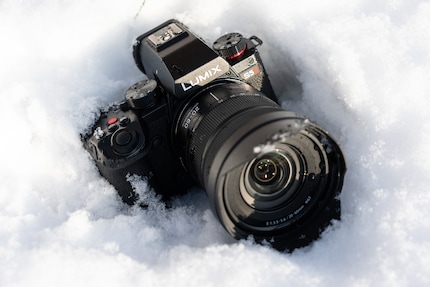
Source: Samuel Buchmann
Inside the camera is still a back-illuminated CMOS sensor with a resolution of 24.2 megapixels, stabilised on five axes. However, the autofocus system is new. Panasonic has finally switched to a combination of contrast- and phase-detection autofocus. In addition, the continuous shooting speed has increased. It’s now up to 30 frames per second (fps) with electronic shutter and 9 fps with the mechanical shutter.
Panasonic has also improved the connections. The S5 MKII now has a full-blown HDMI output instead of the error-prone mini-HDMI of its predecessor. This should please videographers who use external screens. The new Panasonic should be interesting to them, as it films at up to 6K resolution at 30 fps. This leads to higher data rates. Fortunately, both SD card slots now support the UHS-II standard. The port covers have become slightly smaller and now get less in the way of the unfolded display.
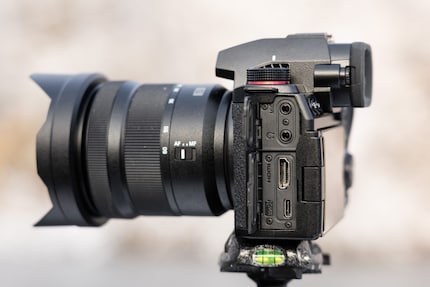
Source: Samuel Buchmann
Here’s an overview of the important specifications:
| Panasonic S5II | Canon R6 MK II | Sony A7 IV | |
|---|---|---|---|
| Resolution | 24 megapixels | 24 megapixels | 33 megapixels |
| Sensor type | Back-side illuminated | Front-side illuminated | Back-side illuminated |
| Burst shooting | 30 fps (electronic)
9 fps (mechanical) | 40 fps (electronic)
12 fps (mechanical) | 10 fps |
| Stabilisation | Up to 6.5 levels | Up to 8 levels | Up to 5.5 levels |
| Flash sync | 1/250 s (mechanical) | 1/200 s (mechanical)
1/250 s (electronic) | 1/250 s (mechanical) |
| Electronic viewfinder | 3.68 MP
0.78x | 3.68 MP
0.76x | 3.69 MP
0.78x |
| Rear monitor | 1.85 MP | 1.62 MP | 1.04 MP |
| Video | 6K 30p (1.0x)
4K 30p (1.0x) 4K 60p (1.54x) | 4K 30p (1.0x)
4K 60p (1.0x) | 4K 30p (1.0x)
4K 60p (1.5x) |
| Dimensions | 134 × 102 × 90 mm
740 g | 138 × 98 × 88 mm
670 g | 131 × 96 × 80 mm
659 g |
| Memory | Dual SD (UHS-II) | Dual SD (UHS-II) | 1 × CFe / UHS-II SD
1 × UHS-II SD |
Handling: feels logical and intuitive
I really like operating the S5II. I rarely get my hands on Panasonic cameras, yet got on well with the new Lumix from the get-go. The menus are clean, logically structured and understandably labelled. After a short learning curve, I quickly find all the settings I’m looking for. There are dedicated buttons for the most important things, and I can access the most important image settings using the Q button on the back.
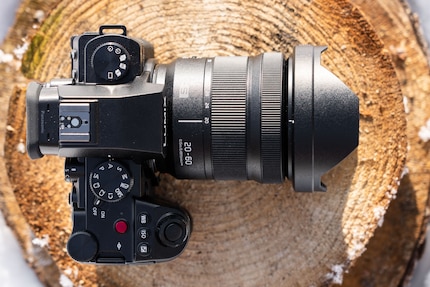
Source: Samuel Buchmann
The thumb joystick for selecting the focus field has become larger and now works in eight directions instead of only four like on the predecessor – a very welcome improvement, as it’s one of the controls I use most. At the top left, there’s a dial that allows me to switch between single and continuous shooting as well as to – and this is a new feature – High Resolution mode. The red record button for video recordings is also located at the top. This easily accessible position is convenient when I want to film myself. I only find the AF-ON button suboptimal; it sits right where my thumb rests and feels squishy. But that’s the only thing I’ve found to grouse about.
Display and viewfinder: could be better
I am somewhat disappointed in the electronic viewfinder. With 3.68 million pixels and 0.78x magnification, it is indeed better than on the S5. Still, it doesn’t look particularly clear or sharp to me. I’m used to the lifelike image quality on the Sony A1 – its viewfinder has 9.44 million pixels. Mind you, this is an unfair comparison, given the S5II is in a different price range. But even within the same segment, other manufacturers’ viewfinders look better. For example, I can judge sharpness and exposure better on the Canon EOS R6 Mark II.

Source: Samuel Buchmann
The S5II’s viewfinder is less fun to shoot with, even if it doesn’t directly affect the image quality. And here’s the thing: Panasonic knows how to do better. Back in 2019, the S1 was the first camera ever to feature an OLED viewfinder with 5.76 million pixels. Sure, this would have made the new S5II a bit more expensive. But the extra charge would’ve been worth it. Like this, the viewfinder is the weak link in an otherwise very well-balanced camera.
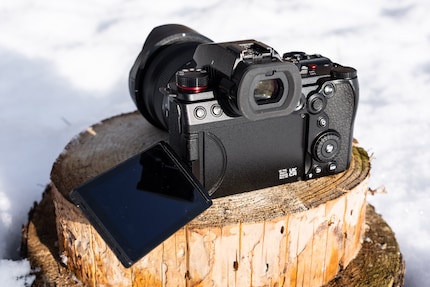
Source: Samuel Buchmann
If you’re mainly filming, this shouldn’t bother you as much. The screen on the back is good – you get 1.85 million pixels on a three-inch display that can be folded out and rotated.
Autofocus: a hybrid system, finally!
What’s very pleasing is the development in terms of autofocus. The Lumix S5 MKII is the first Panasonic to have a hybrid system that combines contrast- and phase-detection autofocus. This has long been standard for all other manufacturers, but Panasonic has stubbornly stuck to its purely contrast-based DFD («Depth from Defocus») technology until now. This was fine for photography in most situations, but far too inconsistent and unreliable for video. Anyone who shoots video will know that anything less than an absolutely reliable autofocus system is useless. While Panasonic users were left struggling with the limitation of DFD, the already superior systems from Sony, Canon and Nikon kept getting better. By now, they can track eyes, faces, animals, or freely selectable objects with virtually no errors.
Has the Lumix S5II finally caught up with the competition? Not quite, but it comes very close; it probably even surpasses Nikon. Throughout my tests, the camera reliably captures my face and maintains focus as I move. When I step into the frame, however, it takes a moment for the Lumix to find me. When I step out, the focus sometimes takes about two seconds to shift to the background. It did also get overwhelmed one time when I turned my back to the camera and ran away. My Sony A1 is faster, more reliable, and, most importantly, smoother. The Panasonic shifts the plane of focus rather jerkily. Here’s a video for comparison:
This comparison applies to other newer Sony cameras; their autofocus is similarly flawless. They also have excellent tracking for freely selectable objects, which is missing on the Panasonic. In addition, the system on the Canon EOS R6 Mark II feels more polished. Even so, the S5II is streets ahead of its predecessor. The old S5 gets completely overwhelmed by people in motion. The following is a direct comparison which showcases the enormous progress:
Panasonic is well-known for comprehensive firmware updates. My test device doesn’t yet have the final version installed. Hence, there’s hope that subject recognition and tracking could still be improved through a software update. But even in its current state, the Lumix S5II’s autofocus is a quantum leap for Panasonic. The hybrid system is not quite as infallible as Sony’s – but it’s no longer a deal breaker for recording video. In most situations, I’d trust the autofocus enough to simply let it do its thing.
Image quality: good dynamic range and high-resolution mode
At the time of testing, I unfortunately can’t yet open the Lumix S5II’s RAW files. They’ll only be supported after the release of Lightroom or Panasonic’s own converter. So, my assessment of image quality refers to JPGs. But that’s not too bad; the S5II seems to take pictures exactly like its predecessor. Here’s what I mean: according to DPReview’s test chart, the dynamic range is at least as good as the current competitor models – i.e. the Sony Alpha 7 IV, Canon EOS R6 Mark II and Nikon Z6 II – if not better.

Source: Samuel Buchmann
Noise performance and details are also on a high level. When it comes to the 24-megapixel resolution, you’ll have to decide for yourself if that’s enough. I, for one, prefer higher resolutions; the larger amounts of data don’t bother me. But for many photographers, the S5II probably strikes the right balance between detail and file size.

Source: Samuel Buchmann
Panasonic also has a trick up its sleeve to increase the resolution. Namely, High Resolution mode, which snaps four pictures with a slightly shifted sensor. The S5II combines these directly on the camera to create an image with a 96-megapixel resolution – in JPG or RAW format. The fact that the images are processed onboard keeps the workflow simple, which I think is great. Images captured using this mode offer significantly more detail than the standard resolution. For High Resolution mode to work, however, you must shoot from a tripod. That means it’s only suitable for things like landscape or architectural photography.
Video: excellent quality and professional features
When it comes to video, the Panasonic Lumix S5II is in a higher class than its price would suggest. It films in 6K at up to 30 frames per second (fps) in 10 bits, 4:2:0. In 4K resolution, you can get up to 60 fps in 10 bits, 4:2:2. However, if you shoot at over 30 fps, the image is cropped by a factor of 1.56, i.e. down to APS-C size. The new Canon EOS R6 Mark II does this better, using the full sensor in oversampling even at 60 fps. Besides the classic 16:9, the S5II also offers the 17:9 format. The S5II no longer has its predecessor’s 30-minute recording limit, and overheating shouldn’t be a problem anymore either.
My test shows that the recording quality on the S5II is excellent. The V-Log/V-Gamut colour profile has a high dynamic range that feels better than that of the Canon R6 MK II. Panasonic speaks of «14+» levels, which would be roughly equivalent to the Sony A7 IV. I can’t verify this exactly, though. I do, however, film a backlit scene in my test in DaVinci Resolve. In the autofocus test videos higher up in this article, which were filmed using the default profile, the sky is completely overexposed. This doesn’t happen when filming in V-Log. Despite the extremely high contrast, details are preserved in both the dark and bright areas – even if some noise is noticeable when brightening the shadows. What I also like about Panasonic’s Log Profile are the colours. A simple colour space transformation makes skin tones look very natural.
The sharpness stays good, be it in 24, 25 or 30 fps. 4K recordings are about on par with those of other full-frame cameras, with the Canon R6 MK II carving out a slight lead. This changes when I increase the Panasonic’s resolution to 6K and subsequently downsample to 4K on average; this improves quality noticeably. Only the Sony A1’s scaled 8K looks even better. When it comes to higher frame rates, the Canon R6 MK II clearly wins thanks to oversampling. Mind you, all these differences are extremely small in practice and only become apparent when you digitally zoom into videos during editing.
The Lumix doesn’t show any weaknesses at high ISO values. Like its predecessor, the S5 MII has two native ISO values: 100 and 640 in the normal colour profile, 640 and 4,000 in V-Log. Noise performance is in line with that of competing cameras. The rolling shutter is reasonably under control, though not quite as good as on the Canon R6 MK II, the new benchmark in this price range.
In addition to image quality, another praiseworthy aspect about the S5 MKII is that it includes many professional features. Its direct setting for the shutter angle, the waveform and vectorscope as well as its support for anamorphic lenses set it apart from other models in this price range. Custom LUTs can also be loaded onto the camera.
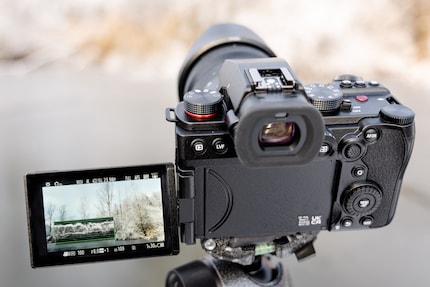
Source: Samuel Buchmann
Verdict: a clear recommendation
The Lumix S5II is a serious alternative to the usual hybrid suspects, the Canon EOS R6 Mark II and Sony Alpha 7 IV. Its image quality is at the very least on equal footing, and, in terms of dynamic range, it even somewhat surpasses the competition. In addition, there are well-implemented features, such as High Resolution mode, and operating the camera is intuitive. The only downsides for me are the subpar electronic viewfinder and the angular casing. Panasonic’s range of lenses isn’t yet particularly large, but the quality is good. The L-mount can also be used with lenses from other manufacturers.
I find the S5II especially shines when it comes to shooting video. In frame rates up to 30 fps, quality is above the level I’d expect at this price point. Videos scaled on average to 6K also outperform the 4K oversampling on the Canon 6D MK II. It’s only if you prefer to shoot in 48 to 60 fps that the Canon 6D MK II is the better choice; that’s when the Lumix S5II switches to the APS-C crop. On the other hand, the Lumix S5II is the only camera in its price range to offer professional tools such as a waveform display and native support for anamorphic lenses. Panasonic’s V-Log profile is also very pleasant to grade.
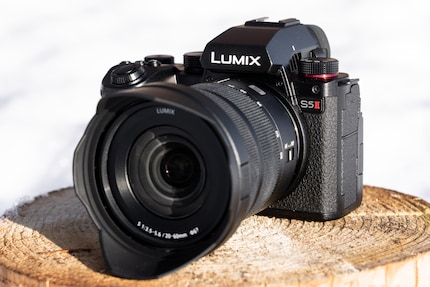
Source: Samuel Buchmann
Thankfully, the autofocus is finally up to speed; the new hybrid system is no longer overwhelmed by faces in motion and does a good job in videos. Of course, Sony cameras focus even more reliably, quickly and smoothly. The S5II also lacks generic object tracking, but I’m hopeful that Panasonic will further improve autofocus through firmware updates. After all, the manufacturer is known for its comprehensive updates for existing cameras. And even in its current state, autofocus is good enough to no longer ruin everything else.
Overall, I’d say the Panasonic Lumix S5II on par with its competition. Which camera is right for you depends on your personal preferences. Want the very best autofocus and a bit more photo resolution? Then the Sony A7 IV is better. You’re after perfect ergonomics and no crop in 60 fps videos? Then the Canon R6 EOS R6 Mark II is the camera for you. But if you’re looking for the best dynamic range and the sharpest videos at up to 30 fps, then the Lumix S5II will give you just that – at a fair price.
My fingerprint often changes so drastically that my MacBook doesn't recognise it anymore. The reason? If I'm not clinging to a monitor or camera, I'm probably clinging to a rockface by the tips of my fingers.



